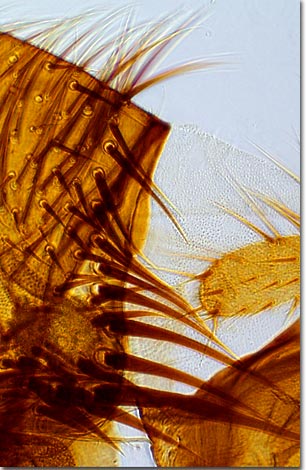Phase Contrast Image Gallery
House Fly Mouthparts
The often maligned common house fly, Musca domestica, is generally thought to be a nuisance and vector for many diseases that affect both humans and animals. This is due largely to the eating habits of this species.

Flies eat just about anything and everything, using their feet to touch every potential food item to see if it tastes good. Fruit, sewage, candy, or rotting garbage; they're all equally delicious to a house fly. In the process of tasting everything, of course, a multitude of bacteria and viruses are spread from everything the fly contacts.
Although some flies can bite, the house fly can't. Its mouthparts are made of soft, spongy structures called a labella and a proboscis. The labella gently dabs liquids into the proboscis, which then sucks up the liquid. If the fly encounters solid food it wants to eat, it drops saliva onto it, turning the food into a liquid.
House flies are among the speediest of insects with an average speed of about five miles per hour (mph) with bursts to 15 mph when threatened. The rapid beating of their wings (about 1,000 times per second) is responsible for the buzzing noise that accompanies a close fly-by. The sensitive antennae of the fly is responsible for detecting both food sources and changes in air currents which signal the approach of enemies.
Flies lay up to 1000 eggs in some of the most undesirable settings such as garbage, decomposing plant and animal matter, feces, manure, and spoiled food. Although more abundant in the warm spring and hot summer weather, house flies may exist year-round in temperate climates, where their life cycles occur every eight days.
The life-span of a typical fly is about 21 days, but they can live much longer in cool weather, although their metabolism and active movement is severely reduced. The average fly is between five to eight millimeters in length and they range from gray to dark brown with dark stripes on the thorax. The abdomen is colored yellow on the sides, and the eyes are often red or green. The larvae are cylindrical white maggots that average about a centimeter in length and taper off at the ends. Puparia are reddish-brown and are about half the size of the larvae.
BACK TO THE PHASE CONTRAST GALLERY
